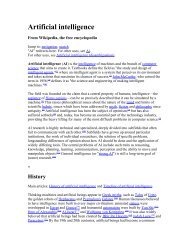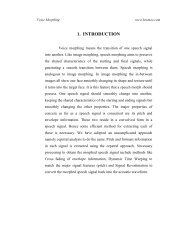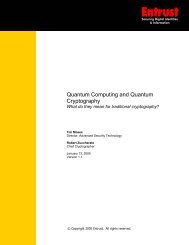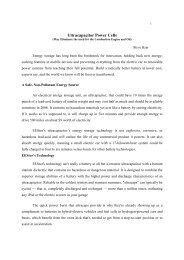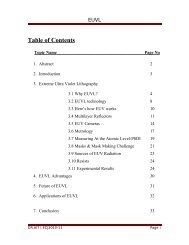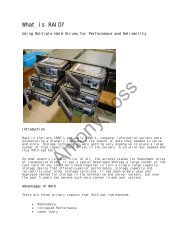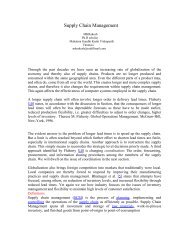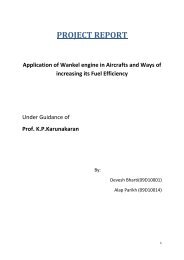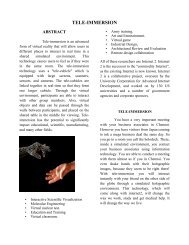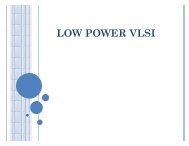SKY BUS METRO - 123SeminarsOnly
SKY BUS METRO - 123SeminarsOnly
SKY BUS METRO - 123SeminarsOnly
You also want an ePaper? Increase the reach of your titles
YUMPU automatically turns print PDFs into web optimized ePapers that Google loves.
<strong>SKY</strong> <strong>BUS</strong> <strong>METRO</strong><br />
Seminar by<br />
K. Deepak Kumar Subudhi<br />
deepaksubudhi456@gmail.com<br />
0501227456<br />
8th sem,ME2-A
Sky Bus metro<br />
moves people and cargo too!<br />
At 100 kmph along existing roads &<br />
aesthetically, without demanding road space!<br />
Better performance than underground metro<br />
at one-fourth cost & up and ready in two years<br />
Futuristic automated driver –less operations!<br />
Sky Bus concept first presented by B. Rajaram in 1989<br />
At Bologna University Italy<br />
“Technically sound..”<br />
Dr. APJ Abdul Kalam
Cities are getting choked<br />
• Existing metro solutions are :<br />
– financially unviable and<br />
– further will add to long term misery<br />
– Makes states & people poorer<br />
Old generation financially unviable<br />
metros re-packaged draining<br />
people’s wealth
Evolution of Sky Bus..<br />
Result of 150 years of experience of railways!<br />
The railway on bridge comfortable!<br />
Sky Bus has<br />
The same rail tracks.<br />
The same bridge<br />
The same driving bogies<br />
Only coach is now Suspended, better stability- positive<br />
Hold provided<br />
Noise is positively Entrapped
Surface, elevated or<br />
underground metrosnot<br />
safe enough<br />
Derailments/capsizing<br />
kill people<br />
Sky Bus no derailment &<br />
No capsizing- SAFEST in<br />
the world
Conventional railway<br />
provides for heavy<br />
steel coaches to<br />
protect people from<br />
derailments and<br />
capsizing. So carry<br />
more steel and dead<br />
weight instead of<br />
people.<br />
With total weight of 48T,<br />
a railway can carry only<br />
70 persons in20m length<br />
Aesthetic , Futuristic Eco-friendly<br />
Economic & Safest Sky Bus Metro<br />
Why Sky Bus saves 50% to 75% in costs!<br />
Sky Bus has no<br />
such problem;no<br />
derailment nor<br />
capsizing; hence<br />
uses very light<br />
weight coaches<br />
and carries more<br />
people using much<br />
less dead weight<br />
Sky Bus with the<br />
same weight & length<br />
carries 300 persons<br />
comfortably<br />
So Sky Bus requires<br />
Only 50m long stations<br />
to service 900 persons<br />
every 40 sec. While<br />
existing metro system<br />
need 200m and 90 sec.
DESCRIPTION<br />
Heavy 52/60 kg /m rails placed at standard gauge floating elastic<br />
medium and damped by inertia of measured mass held in a 8 mX<br />
2m box enclosure, supported over a 1m dia. columns spaced at 15<br />
m and located at 15 m distance from each other, in the divider<br />
space in between lanes on a road- way, at a height of 8m above<br />
road surface- provides the support and guidance for powered<br />
bogies which can run at 100 kmph, with the coach shells<br />
suspended below , carry passengers in air conditioned comfort, can<br />
follow existing road routes, while existing traffic on roads continue
The fixed structure at 8 m height above road level is<br />
aesthetically pleasing and there is no concern of<br />
claustrophobic feeling for road users.<br />
Aesthetic and eco-friendly, the Sky Bus can never<br />
derail, capsize nor collide- by design as well as by<br />
construction, hence is safer than existing rail-based<br />
system. With no signaling and having no points and<br />
crossings, it is a unique mass-transit system, which can be<br />
put up within two years in any crowded & congested city.<br />
Sky Bus metro falls under tramway category, under Art<br />
366(20) of Constitution of India, since it operates along<br />
existing roadways and within municipal limits, hence<br />
excluded from Indian railway act.
WORKING PRINCIPLE<br />
•Standard railway coach running on railway<br />
track<br />
•The under frame with standard railway wheel<br />
set running on railway track
•The under-frame remains same, railway wheels run<br />
on the same track, the coach is firmly attached to the<br />
under-frame positively .<br />
•The under-frame with wheels and railway traction<br />
motors & railway track enclosed in the concrete<br />
box- travel on the railway track , carrying the coach<br />
below outside the concrete box- now the coach<br />
and the track are positively held together- cannot<br />
escape from rails!
COMPONENTS<br />
The various components are designed so that to keep the sky<br />
bus moving without any defect and to give the passengers the<br />
ultimate comfort along with other luxurious facilities which<br />
they can not get in the local buses or in trains.<br />
Sky way<br />
Sky Bogie
Sky Coaches<br />
The traverser arrangement<br />
Sky Coaches<br />
Sky Station
Salient Features<br />
• Standard Gauge Rail tracks :60 kg rails fitted with double<br />
elastic fastenings, with Standard Gauge on<br />
sleepers designed & tested for 20 t axle load norms<br />
forming maintenance<br />
free tracks.<br />
• Driving bogies:100 kmph standard gauge 12 ton/14 ton<br />
axle load powered bogies -same<br />
as used in metro rails with 4x110/115 Kw asynchronous<br />
3 ph AC motors<br />
with power-regeneration and capable of peak<br />
1.3m/sec/sec acceleration<br />
• Braking: Electrical re-generative braking, coupled with<br />
compressed air disk<br />
mechanical brakes and emergency/ idling mechanical<br />
brakes for stabling.
•Crushing load for underframe:Underframe- fit to take<br />
crushloads of regular main line coaches- more than<br />
70t<br />
•Train unit: Each train unit 20m long with two driving bogies-<br />
the coach divided into 2x9.5 m long buses connected<br />
through vestibule door<br />
•Capacity of 20m long train unit: Each Skybus unit 20m long<br />
having two compartments( 3.25m x 9.5m) of 9.5 m , can<br />
carry almost 400 persons at 7 persons/sq.m density peak.<br />
The 20 m units can be attached to form a 3 unit, 60m long<br />
train of 1200 persons capacity
•Signal & train control: Simple three aspect signal system driven<br />
by line of sight by motorman,<br />
with additional unique safety layer of Raksha Kavach, capable of<br />
providing<br />
40 sec headway- but planned 60 sec.<br />
•Route Capacity: A Sky bus route can thus be designed even at<br />
60 sec headway, to carry 20,000 to 70,000 passengers per hour<br />
per direction in peak period.<br />
•Security and safety: Continuous computerized central monitoring<br />
& control with provision of audio/visual access for each coach for<br />
security.<br />
Distributed intelligence systems with redundancy to provide<br />
protection against swinging under wind loads/emergecy localised<br />
control/ prevent over-loading/ emergency evacuation guidance.
•Track changes and reversals at terminals: The reversal for<br />
the Skybuses at terminal points, to change tracks or go to<br />
depots happens through traversers- mechanical auto driven<br />
systems capable of handling 60m consists of Sky bus units.<br />
•Stations-elegant and small: Stations are 60m long to handle<br />
three units of Sky bus, covering next 25 years of<br />
requirements-though initially only 20m length is needed.<br />
•Easy Access: Access is from existing footpaths, climb<br />
limited to 6 m for passengers- within 500 to 600m from<br />
wherever you are on the road having Skybus<br />
route.
•Turning radius & gradient: Can be designed for 20m radius of<br />
turning radius, and vertical lift, if needed- thus we can avoid<br />
totally demolition of any built up urban<br />
property, if needed.<br />
•On line maintenance of rolling stock and tracks: Maintenance is<br />
through continuous monitoring of vibration signatures, and<br />
directed by need automatically by computerized systems- much<br />
more advanced than existing manual inspections only and<br />
periodic checks.<br />
All the sub-systems /elements are to existing UIC/Indian Railway<br />
codal practices applicable to railway transport.<br />
•Cargo handling capability: Cargo of standard containers are<br />
automatically delivered and cleared into and out of city.
•Safety Certification for Public carriage: Will carry international<br />
class safety certification by renowned world class<br />
safety certifiers.<br />
Guaranteed against derailments and capsizing- making it a<br />
unique railway,<br />
where coaches can never escape the tracks.<br />
•Terminal concept: Current concept of a railway terminal<br />
replaced in this "grid" system, by a multi point distributed<br />
discharge and access- almost eliminating inter-modal transfers.<br />
Each station designed for handling whatever commuters<br />
can arrive on a 4m wide foot-path- with waiting time less than<br />
one minute.
•Land requirements for route, stations and at depots: All along the<br />
route the alignment is typically located on the median ( 1.2m<br />
diameter columns at about 20m spacing) of the road, needing<br />
right of way at 6.5m above the road, the fixed structure carrying<br />
railway tracks located at about 11m- thus avoiding claustrophobic<br />
effect for road users. Typical road widths normally of 10m all along<br />
and at station locations 20m width for 60m length desirable.<br />
Depots will be outside the urban areas, needing about 25 hectares<br />
land for services for every 10 km route.<br />
Stations are located with access from existing footpaths, and over<br />
and above existing roadways, none of them longer than 60m to<br />
cater to next 100 years of requirements
•Power requirements: Typically for tropical climate conditions, for<br />
a module of 10 km route, 15<br />
MW power needed covering traction and all services including<br />
comfort air-conditioning loads at stations.<br />
•Quality of service and pricing: With access within 500 to 700m<br />
walking distance, air-condition travel at<br />
100 kmph , service available at less than a minute during peak<br />
hours,<br />
priced at Re 1.50 per km falling to Re 1 for regular travels with<br />
lead of<br />
more than 7km can be provided. typical) (year 2005)- if rider ship<br />
per a 10<br />
km route is a little more than 3 lacs per day.
•Cost estimation:<br />
Reduces cost of transport with quantum jump In quality of life<br />
Sky Bus is affordable & adds wealth!<br />
Capital cost for a 10 km routeRs 500 cr<br />
Annual Capital service charges 10% 50<br />
Annual Operation&Maintenance 10% 50<br />
Expenditure Rs 100 cr<br />
Revenue<br />
At Rs 500 per month 2 lac families 120<br />
( A family gets 3 travel cards to avail<br />
1000 k in peak period and 1000 km<br />
in non-peak period. Virtually 25ps/km!)<br />
Floating Population 50000 at Rs 50/day 90<br />
Revenue from tickets Rs 210 cr<br />
Operating surplus Rs 110 cr<br />
22%<br />
Suppose only 50% of projection materialises<br />
even then a minimum of 10% return is assured.
Comparative Costs for a 10 km route to carry 40,000 pass/hr:<br />
• Underground Metro………………………Rs 2,500 cr<br />
• Elevated Metro……………………………Rs 1200 cr<br />
• Sky Bus Metro…………………………….Rs 500 cr
SAFETY MEASURES<br />
• Compared to conventional railway systems, the centre of<br />
gravity of the mass being carried on the wheels is<br />
brought down to be closer to the wheel support- hence<br />
dynamic safety is many time improved<br />
• In conventional railway wind can topple the trains. In Sky<br />
Bus wind cannot topple- there is positive link between the<br />
rail guidance system and the Bus Coaches- with 400%<br />
• The railway bogies in conventional system have<br />
propensity to lose control on derailment, but additional<br />
safety in Sky Bus bogie is that we have derailment<br />
arresters, which prevents the wheel from jumping off the<br />
rails. So we are ensuring that there is no derailment.<br />
safety factor built into multiple suspenders
Raksha Kabach<br />
•The chances of collision between two skybuses is nearly<br />
zero. Because the well tested anti collision device developed<br />
by Er.B.Rajaram called as “RAKSHA KABACH” will be there<br />
in each sky bus bogie.<br />
In normal railway systems, when collision takes place,<br />
derailment also occurs, and carriages capsize killing people.<br />
But in Sky Bus no collision can take place between the<br />
coaches- even after the 3 levels of braking fail and the Sky<br />
Bus units hit each other in a collision, the Sky Coaches in<br />
which people are traveling, will only swing to and fro- but will<br />
not collide with each other nor capsize.
But, if there will be any problem occurs in the skybus during its<br />
running and it has to be stoped between two sky station, then<br />
there are the safety air bags are provided with each coaches<br />
for emergency exit of the passengers in the mid way.
• Fast transportation<br />
• No land acquisition<br />
problem.<br />
• No demolition<br />
• No Vandalism<br />
• Fire Protection<br />
• No capsizing<br />
• No Deaths<br />
• Deep Penetration<br />
• Lowest Operational<br />
cost.<br />
• No interference with<br />
normal road traffic<br />
ADVANTAGES<br />
• Low Capital cost<br />
• Fast Clearance<br />
• Better Capacity<br />
• Flyover<br />
• Fast Execution<br />
• No Pollution<br />
• No Force Major<br />
• No traffic Jams, No<br />
waiting<br />
• Comfort<br />
• Easy Access<br />
• Amenity<br />
• Luxury & Comfort
conclusion<br />
The Skybus is the technology breakthrough that India has<br />
achieved. Skybus is an improved railway technology, eliminating the<br />
problems of existing metro rail systems, like, derailments collisions,<br />
and capsizing crushing people. Old conventional railway men, who<br />
remained basically operating and maintenance experts, may take a<br />
little time to appreciate, but the fact remains Skybus is an improved<br />
railway technology eliminating their fears of derailments and<br />
capsizing from which they suffered for decades!<br />
Financially Skybus Metro makes urban transport a dream come<br />
true for administrators- virtually free gift to people without<br />
Government fund in<br />
What needs to be done is to eliminate the doubting Thomas in<br />
our minds, and adopt the Skybus, if we want to really solve the<br />
urban transport crisis!. The Sky Bus metro is one single technology<br />
which can change the face of our cities, take out almost 10 million<br />
road vehicles in the cities and make the cities livable, improving<br />
quality of life and attract and sustain economic activity to generate<br />
wealth.
BIBLIOGRAPHY<br />
• www.atrilab.com<br />
• www. konkanrailway.com<br />
• www.google.com<br />
• www.wikipedia.com<br />
• http://skybus.blogspot.com<br />
• http://skybus.metro.googlepages.com<br />
• Rail International -Brussels May 1983:- A simple<br />
approach to study rail wheel interaction - Author- B<br />
Rajaram<br />
• Rail International -Brussels April 1984:- A New<br />
Theory of Rail Wheel Interaction - Author- B<br />
Rajaram



